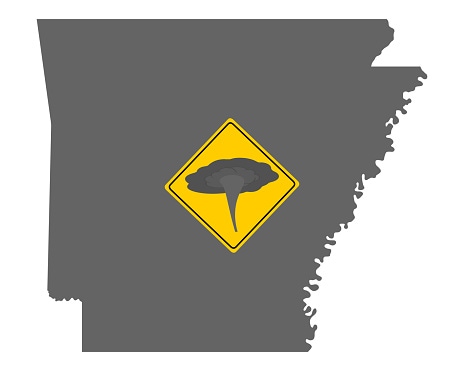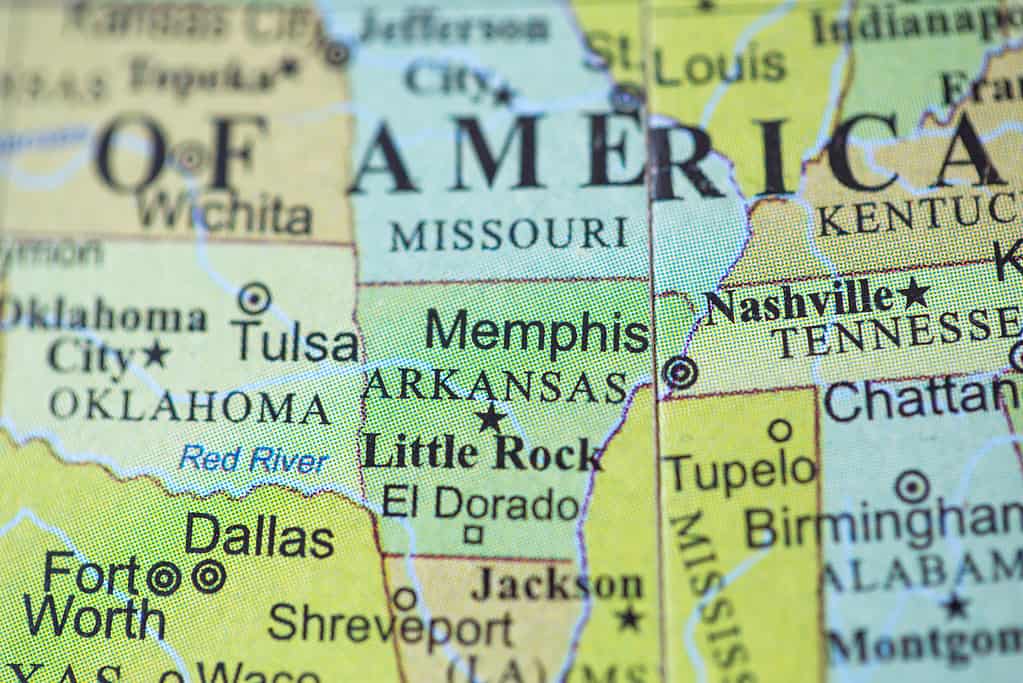
Arkansas typically has at least 30 tornadoes annually.
©lantapix/iStock via Getty Images
As families prepared to gather around the table for Thanksgiving on November 25, 1926, little did they know that their holiday would be cut short by devastation. A string of tornadoes tore through parts of central and eastern Arkansas, and a total of 64 people died as a result of the storms. The tornado outbreak caused at least $630,000 in damages, which is the equivalent of more than $10.8 million in 2023. As we prepare for this Thanksgiving, let’s take a look back in history at the biggest Thanksgiving tornado outbreak to ever hit the American South.
The Setup for the Perfect Storm
Back in 1926, with meteorology in its infancy, there was little understanding of how atmospheric conditions were shaping up to create multiple storm systems across Arkansas and Louisiana. Later on, the National Weather Service was able to ascertain data that indicated how a low-pressure system was developing in the Northern Plains, carrying a cold front toward the southern states. To the east, there was a warm front. The combination of these systems was enough to create a dangerous storm front.
On Thanksgiving Day, November 25, 1926, temperatures were nearly 20 degrees warmer than normal in Arkansas. Temperatures were in the 50s and 60s, and by the afternoon, some locations climbed as high as 70 degrees. As the cold front began to merge with the warm front, the warm front started to rise, meeting windy conditions. As these systems collided, the tornadoes began to form.
The Thanksgiving Tornado Outbreak Unfolds
With the hustle and bustle of gathering around tables for a Thanksgiving meal, very few people recognized the weather warning signs. This distraction, coupled with little meteorological forecasting, meant that there was no preparation or indication that Thanksgiving 1926 would quickly turn disastrous. The lack of warning systems and a solid communication infrastructure left communities across Arkansas and Louisiana ill-prepared for the severity of the storms preparing to strike.
The tornado outbreak of 1926 was unprecedented in terms of its scale, destruction, and multitude. Some claim that 27 tornadoes were reported. However, data collected from the National Weather Service suggest there might have only been 14 tornadoes. Regardless of what the total number actually was, there was an abundance of tornadoes across Arkansas, spreading into Louisiana. Many of these tornadoes decimated homes and towns, leaving a trail of destruction that extended for miles across the southern states.
Based on data and evidence, it is assumed that the first tornado touched down around 4 p.m. near Belleville, Arkansas. The last tornado was spotted around Lincoln County near 10 p.m.
A Survivor’s Account of the Thanksgiving Tornadoes
Christina Doyle Spear wrote about the Thanksgiving tornado outbreak of 1926 in her 2001 book Something Money Can’t Buy. As she recollects the experience, she notes how the weather was far too warm for the November holiday. The wind was blowing in circles, and eventually, Christina’s parents noted the dark clouds, vibrant lightning, and rumbling bouts of thunder. It was then that her parents moved the family to a nearby storm cellar.
Christina and her family were located in White County, Arkansas, which is southeast of Heber Springs. At approximately 5:30 p.m., a tornado tore through the town of Heber Springs, leaving death and devastation in its wake. Heber Springs experienced the worst of the Thanksgiving tornado outbreak.
The Significant Tornadoes

Arkansas is considered a southern state, although it is on the periphery of the Midwest.
©victormaschek/iStock via Getty Images
The tornado struck Heber Springs just as many families were starting dinner. Not only was the town flattened, but a number of fires exacerbated the devastation. Families were using wood stoves to prepare their meals as the storms hit. The fires from these stoves ripped through the remains and ruins of the town. The Arkansas Gazette reported on the tornado that decimated Heber Springs, emphasizing how the fires added to the “horror” and “terror.”
The newspaper article claimed that the tornado only lasted five or six minutes in total. The Mountaineer Echo later reported that even with over 50 casualties, the death toll couldn’t fully reflect the amount of damage caused by the tornadoes in Heber Springs.
In another town—Moscow, Arkansas—a wedding ceremony had just finished when the tornado struck the church. Sadly, 10 people died and 40 were injured. In Arkansas alone, 58 people lost their lives. Over 200 people sustained injuries.
The Aftermath
The tornadoes wrought horrific damage to several towns across Arkansas. With homes destroyed, farms flattened, and towns decimated, the aftermath was unfathomable. Families were in mourning, struggling to comprehend the loss of life and the magnitude of the damage. Communities were forced to recover with few resources, but people came together and supported one another. Of course, damages were astronomical, reaching upwards of $600,000. The road to recovery was painstaking and challenging.
The Historical Significance of the Thanksgiving Tornado Outbreak in the American South
The Thanksgiving tornado outbreak left a mark on history, and this storm remained the biggest outbreak to occur in Arkansas during November until 2005. In 2005, 24 tornadoes formed near northwestern Arkansas. Luckily, by this time, advancements in meteorology meant better warning systems for communities. Although the Thanksgiving tornado outbreak was tragic, it helped pave the way for severe weather preparedness.
Between Portland, Arkansas and Morehouse Parish, Louisiana, a total of 64 people lost their lives during the Thanksgiving tornado outbreak. As we look back on this moment in history during a season of thankfulness and gratitude, may we remember the importance of community and connection.
Thank you for reading! Have some feedback for us? Contact the AZ Animals editorial team.








